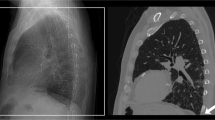Abstract
Objectives
The aim of this study was to determine the frequency and causing factors of excessive z-axis coverage in body CT examinations.
Methods
A total of 2032 body CT examinations performed between 1 March and 1 April 2018 in 1531 patients were included in this study. The over-scanned length values in the z-axis for each CT examination on each patient were determined by calculating the difference between the actual scanned length and optimal scan length in the z-axis. Over-scanning and over-scanning ratios were interrogated in terms of potential underlying factors that can be affected by patient demography, time, the throughput of CT, and the experience of technologists.
Results
Over-scanned CTs in z-axis were 66% of all CTs performed. CT scans were over-scanned in the cranial side in 18.4% and caudal side in 48.5% of patients. Over-scanning was found to be more frequent in 55–64-year-old age group (74%), thorax CTs (89.2%), patients with consciousness change (88.9%), patients with misleading findings related to lung apex or diaphragm on the scout images (76.6%), CTs performed in day shift (66.8 %), in CT with low daily scan (72.4%), and CT scans performed by less-experienced technologists (75.9%).
Conclusions
Over-scanning in z-axis in body CT examinations is not infrequently encountered in routine practice. Awareness of causes of over-scanning in z-axis can be helpful to prevent over-scanning in CT and unnecessary ionizing radiation exposure in patients.
Key Points
• Over-scanning in z-axis frequently occurs in body CT.
• The frequency of over-scanning in caudal side is higher than cranial side.
• Chest CT and any CT performed in following situation were more prone to over-scanning: older patients, patients with consciousness change, presence of misleading findings on the scout images related to lung apex or diaphragm, day shift, CT with low daily scan, less-experienced technologist.


Similar content being viewed by others
Abbreviations
- AEC:
-
Automatic exposure control
- BMI:
-
Body mass index
- CE:
-
Contrast-enhanced
- CT:
-
Computed tomography
- DLP:
-
Dose length product
- PACS:
-
Picture archiving and communication systems
- SPSS:
-
Statistical Package for Social Sciences
- T10:
-
Tenth thoracic vertebra
References
Brenner DJ, Hricak H (2010) Radiation exposure from medical imaging: time to regulate? JAMA 304:208–209
Schauer D, Linton O (2009) NCRP Report No. 160, ionizing radiation exposure of the population of the United States, medical exposure—are we doing less with more, and is there a role for health physicists? Health Phys 97:1–5
Raman SP, Johnson PT, Deshmukh S, Mahesh M, Grant KL, Fishman EK (2013) CT dose reduction applications: available tools on the latest generation of CT scanners. J Am Coll Radiol 10:37–41
Campbell J, Kalra MK, Rizzo S, Maher MM, Shepard J-A (2005) Scanning beyond anatomic limits of the thorax in chest CT: findings, radiation dose, and automatic tube current modulation. AJR Am J Roentgenol 185:1525–1530
Schwartz F, Stieltjes B, Szucs-Farkas Z, Euler A (2018) Over-scanning in chest CT: comparison of practice among six hospitals and its impact on radiation dose. Eur J Radiol 102:49–54
Zanca F, Demeter M, Oyen R, Bosmans H (2012) Excess radiation and organ dose in chest and abdominal CT due to CT acquisition beyond expected anatomical boundaries. Eur Radiol 22:779–788
Cohen SL, Ward TJ, Makhnevich A, Richardson S, Cham MD (2020) Retrospective analysis of 1118 outpatient chest CT scans to determine factors associated with excess scan length. Clin Imaging 62:76–80
Liao EA, Quint LE, Goodsitt MM, Francis IR, Khalatbari S, Myles JD (2011) Extra Z-axis coverage at CT imaging resulting in excess radiation dose: frequency, degree and contributory factors. J Comput Assist Tomogr 35:50–56
Zhang M, Wellnitz C, Cui C, Pavlicek W, Wu T (2015) Automated detection of Z-axis coverage with abdomen-pelvis computed tomography examinations. J Digit Imaging 28:362–367
Kalra MK, Maher MM, Toth TL, Kamath RS, Halpern EF, Saini S (2004) Radiation from “extra” images acquired with abdominal and/or pelvic CT: effect of automatic tube current modulation. Radiology 232:409–414
Lekgabe E, Tran N, Cheung W et al (2015) Single-pass CT chest/abdomen/pelvis for oncology patients: effect on radiation dose and image quality. ESR EPOS. https://doi.org/10.1594/ecr2015/C-1895
Schilham A, van der Molen AJ, Prokop M, de Jong HW (2010) Overranging at multisection CT: an underestimated source of excess radiation exposure. Radiographics 30(4):1057–1067
Funding
The authors state that this work has not received any funding.
Author information
Authors and Affiliations
Corresponding author
Ethics declarations
Guarantor
The scientific guarantors of this publication are Mehmet Ruhi Onur, M.D., and Deniz Akata, M.D.
Conflict of interest
The authors of this manuscript declare no relationships with any companies whose products or services may be related to the subject matter of the article.
Statistics and biometry
One of the authors (İlkay Sedakat Idilman) has significant statistical expertise.
Informed consent
Written informed consent was not required for this study because study being of retrospective
Ethical approval
Institutional Review Board approval was obtained (Decision no: GO 18/557-23).
Study subjects or cohorts overlap
Some study subjects or cohorts have not been previously reported in an article before. This study was presented in ECR 2019 as an oral presentation (B – 1594) in scientific session (SS 1813).
Methodology
• Retrospective
• Cross sectional study
• Performed at one institution
Additional information
Publisher’s note
Springer Nature remains neutral with regard to jurisdictional claims in published maps and institutional affiliations.
Supplementary Information
ESM 1
(DOCX 22 kb)
Rights and permissions
About this article
Cite this article
Yar, O., Onur, M.R., İdilman, İ.S. et al. Excessive z-axis scan coverage in body CT: frequency and causes. Eur Radiol 31, 4358–4366 (2021). https://doi.org/10.1007/s00330-020-07510-4
Received:
Accepted:
Published:
Issue Date:
DOI: https://doi.org/10.1007/s00330-020-07510-4




